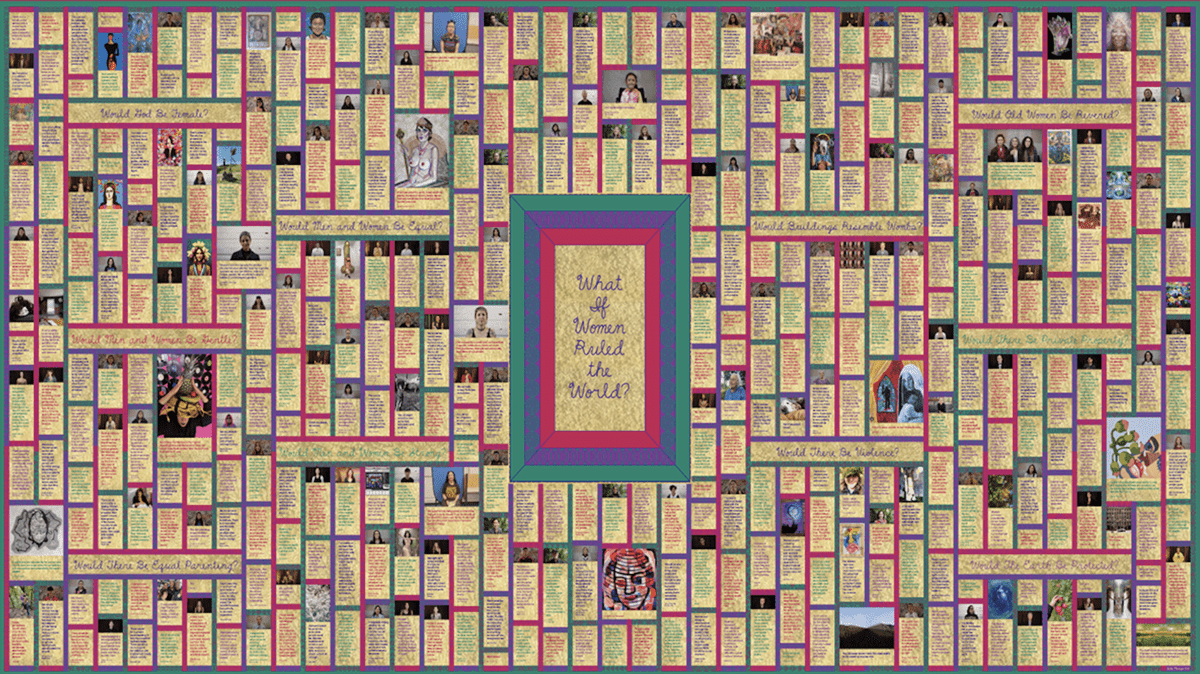
Judy Chicago: Herstory
October 12th, 2023 to January 14th, 2024
New Museum
235 Bowery, New York, NY 10002
From October 12th, the New Museum in NYC will present “Judy Chicago: Herstory.” The exhibit, which aims to bring together six decades of the artist, Judy Chicago’s work, will also include an “exhibition-within the-exhibition” spotlighting women essential to art history and Chicago’s own practice. The exhibit will run until January 14th, 2024, making it Chicago’s most extensive New York museum survey.
For over fifty years, Judy Chicago has consistently championed that art can drive intellectual evolution and societal shift while advocating for women’s rights to partake in elite art creation. Consequently, she has evolved into an emblem for many, recognized and revered as an artist, writer, educator, feminist, and humanist. Her life and work exemplify a broadened understanding of art, a more inclusive role for artists, and the fundamental right of women to express themselves freely.
The exhibition spans four floors of the New Museum, taking visitors over the decades of Judy Chicago’s artist career through paintings, sculptures, installations, textiles, photography, stained glass, and needlework. Also, on the museum’s fourth floor, a total installation featuring Chicago’s carpet designs, embroideries, drawings, and sculptures explores her unique practices by bringing together works from over eighty women and genderqueer artists, writers, and cultural figures who have been essential to her career.

These figures include Hilma af Klint, Hildegard von Bingen, Claude Cahun, Elizabeth Catlett, Simone de Beauvoir, Artemisia Gentileschi, Emma Goldman, Frida Kahlo, Georgia O’Keeffe, Charlotte Salomon, Remedios Varo, and Virginia Woolf, among others. The title of this installation, “The City of Ladies,” named after fifteenth-century Christine de Pisan’s “Le Livre de la Cité des Dames,” continues Chicago’s work as a feminist activist and cultural historian, claiming space for women in narratives that previously masked their contributions. This is similar to one of Chicago’s past influential works, “The Dinner Party” (1974-79), an installation that functioned as a symbolic history of women in civilization.
“Judy Chicago: Herstory” encompasses the entirety of Chicago’s practice, from her 1960s experiments in Minimalism and her revolutionary feminist art of the 1970s to her series of the 1980s and 1990s—such as the Birth Project (1980–85), PowerPlay (1982–87), Holocaust Project (1985–93), Resolutions: A Stitch in Time (1994–2000), and The End: A Meditation on Death and Extinction (2012-1018). All of these expanded the scope of her Second Wave Feminist agenda to confront environmental disaster, genocide, social inequity, birth and creation, mortality, and the construct of masculinity.

Also included in the exhibition are legendary works such as Rainbow Pickett (1965) (originally presented in “Primary Structures” at the Jewish Museum); Atmospheres, her radical performances initiated in 1969, employing colored smoke and fireworks to activate rather than scar the landscape; a suite of visionary abstractions from the 1970s—such as Through The Flower (1973) and the Great Ladies Series (1973)—exemplifying Chicago’s iconography rooted in feminist theory; the Birth Project, a cycle of dozens of works begun in 1980 combining needlework, embroidery, and painting to celebrate the birth process; and documentation of “Womanhouse,” the fabled 1972 installation staged in an abandoned Hollywood mansion by Chicago and Miriam Schapiro’s Feminist Art Program.
These historical works are joined by recent series, including The End: A Meditation on Death and Extinction (2012–18), exploring death as it affects both individuals and the planet, and The Female Divine (2022), a series of eleven monumental banners designed by Chicago and produced by the nonprofit Chanakya School of Craft in Mumbai. Tracing her creative practice across many decades and intersecting art movements, “Herstory” demonstrates the vast range and impact of Judy Chicago’s work over more than half a century.

The exhibition delves into Chicago’s multifaceted roles as a feminist advocate and cultural historian, showcasing her work alongside other women and gender-nonconforming artists, writers, and thinkers. She has ensured their legacies remain remembered through her relentless efforts as a researcher and preserver of history. This exhibition uniquely merges artworks with their foundational materials, highlighting the interplay and echoes of artistic inspirations throughout history. It offers a fresh approach to solo exhibitions, positioning it as an “introspective” instead of a traditional retrospective.
On the Museum’s seventh Floor, the exhibition features two “call and response projects” where Chicago encourages public participation. The International Honor Quilt (1980–87), initiated during The Dinner Party’s world tour (1974–79), allowed people worldwide to contribute small triangular quilts celebrating a chosen woman, expanding the reach of The Dinner Party. In What If Women Ruled the World? (2022), Chicago and Russian dissident Nadya Tolokonnikova of Pussy Riot gathered answers to the title question from individuals in eight countries. These answers are showcased on massive banners on the Fourth Floor, which Chicago designed in tandem with Dior’s Creative Director, Maria Grazia Chiuri’s 2020 couture show. The Seventh Floor serves as a “question center,” inviting the public to envision an equal future with Chicago.

Placing Chicago’s feminist approach amidst numerous art movements she engaged in—from which she has often been omitted— “Herstory” highlights Chicago’s profound influence on American art. It underscores her pivotal role as a cultural historian who gives voice and space to women typically excluded from different art narratives. “Herstory” functions as an extended self-portrait and a reimagined historical archive. It also serves as a solo exhibition and a multifaceted exploration of feminist arts spanning several centuries.
“Judy Chicago: Herstory” is curated by Massimiliano Gioni, Edlis Neeson; Artistic Director, Gary Carrion-Murayari, Kraus Family; Senior Curator, Margot Norton; Chief Curator, Berkeley Art Museum and Pacific Film Archive (former Allen and Lola Goldring Senior Curator at the New Museum), and Madeline Weisburg; Assistant Curator.
The exhibition, sponsored by Dior, is accompanied by a fully illustrated catalog co-published by Phaidon and the New Museum, featuring a conversation between the artist and Massimiliano Gioni and contributions by Glenn Adamson, Connie Butler, Gary Carrion-Murayari, Ann Goldstein, Jennifer Higgie, Candice Hopkins, Amelia Jones, Quinn Latimer, Margot Norton, Kymberly Pinder, Ian Wallace, Madeline Weisburg, and Carmen Winant.



